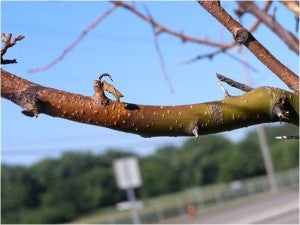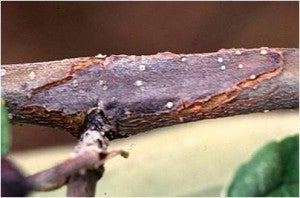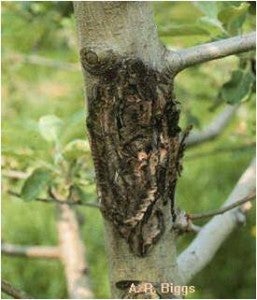April 8 winter moth update
Winter moth eggs are still orange and not ready to hatch. I’ve checked with cooperating egg watchers, and their eggs are still orange too. Eggs turn blue a couple of days before they hatch.
Last night I compared growing degree days (GDD) recorded on the Weather Channel website with winter moth hatch dates from 2008-2014. Now this isn’t very scientific – the weather data may not be accurate; I don’t know exactly what temperature is needed for winter moth eggs to advance; and the hatch date may be a little off, but I think the information could be useful. I found winter moth eggs hatching between 105-152 GDD base 40 when I started calculating GDD on March 1st. Three of those years, eggs hatched within 2 GDD of 114 GDD base 40.
You can check degree days at your location too. See this website:
http://www.yourweekendview.com/outlook/agriculture/growing-degree-days/
Enter your zipcode
Select base temperature 40
Select start date – I suggest using March 1st
Select end date – use yesterday’s date
Click on Calculate
I checked a few locations of GDD base 40 for March 1 – April 7:
Bristol 42
Cumberland 32.5
Greenville 32.5
Kingston 39
Middletown 28
Wakefield 33
Warwick 42
Last year for March 1 – April 7 we were 15-36 GDD, base 40, higher than we are this year. GDD for April 7, 2014 ranged from 53-80. Last year was a late spring and this year is later – as if you didn’t know!
When eggs start to turn blue, apply an insecticide to protect apple, pear, and blueberry flower buds. I know some landscape trees will sprayed then too. Good insecticides to use for fruit include Imidan, Sevin, Delegate, and Entrust (organic formulation of spinosad). If you have a small number of plants to treat you can purchase a small quantity of spinosad called Captain Jack’s Deadbug Brew. It has the same active ingredient as Entrust, but is formulated for home use. It is not certified organic. The landscape formulation of spinosad is Conserve.
Once eggs hatch and the caterpillars climb inside buds, the caterpillars will be protected from insecticide sprays. It doesn’t do any good to spray insecticide after caterpillars are inside the buds and the buds aren’t opened. After buds open and the larger caterpillars start moving around, they are again susceptible to insecticides. At this time, a Bt product (Bacillus thuringiensis), such as Dipel, is also effective at controlling winter moth caterpillars. Bt doesn’t work at egg hatch because the caterpillars don’t feed before they enter buds. Bt needs to be ingested to kill caterpillars.
I will alert you when any monitored eggs turn blue! Eggs are being monitored in Westerly, Kingston, Warwick, Cumberland, and Acushnet, MA.
I hope everyone is finally able to get into orchards and blueberry plantings and prune! Be sure to take out any wood that might be a fire blight canker. Also, every apple orchard should be sprayed with copper at green tip. If you apply copper beyond 1/4 inch green, the fruit may get russetted. Attached are a couple of pictures of fire blight cankers and also pictures of apple bud stages.
Oil can be added to your copper spray to help control European red mite eggs and San Jose scale. You can also add an insecticide, such as Imidan, Delegate or Sevin, to control winter moth caterpillars.
 Home
Home Browse
Browse Close
Close Events
Events Maps
Maps Email
Email Brightspace
Brightspace eCampus
eCampus





